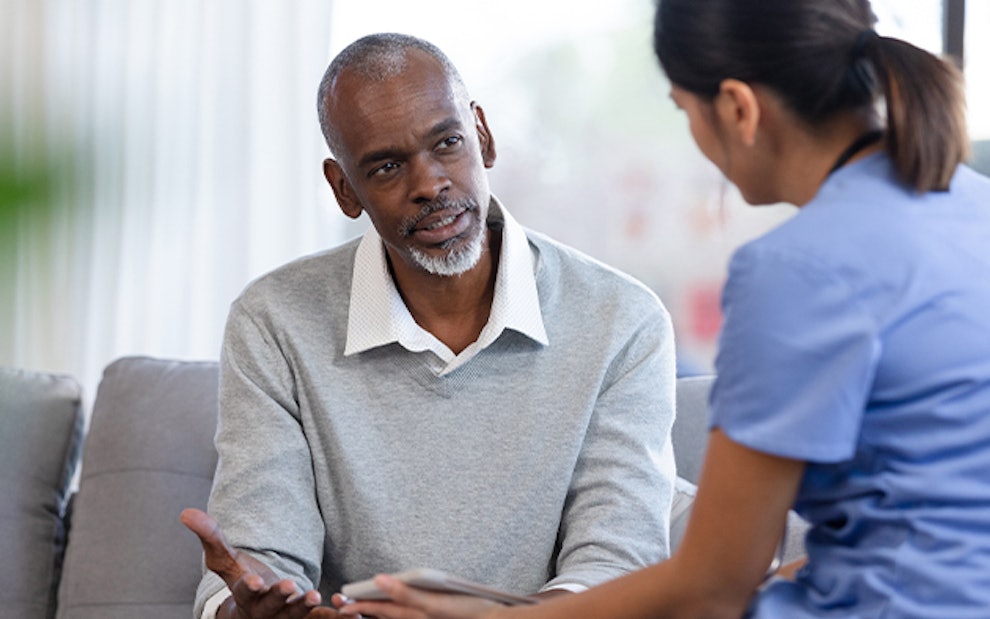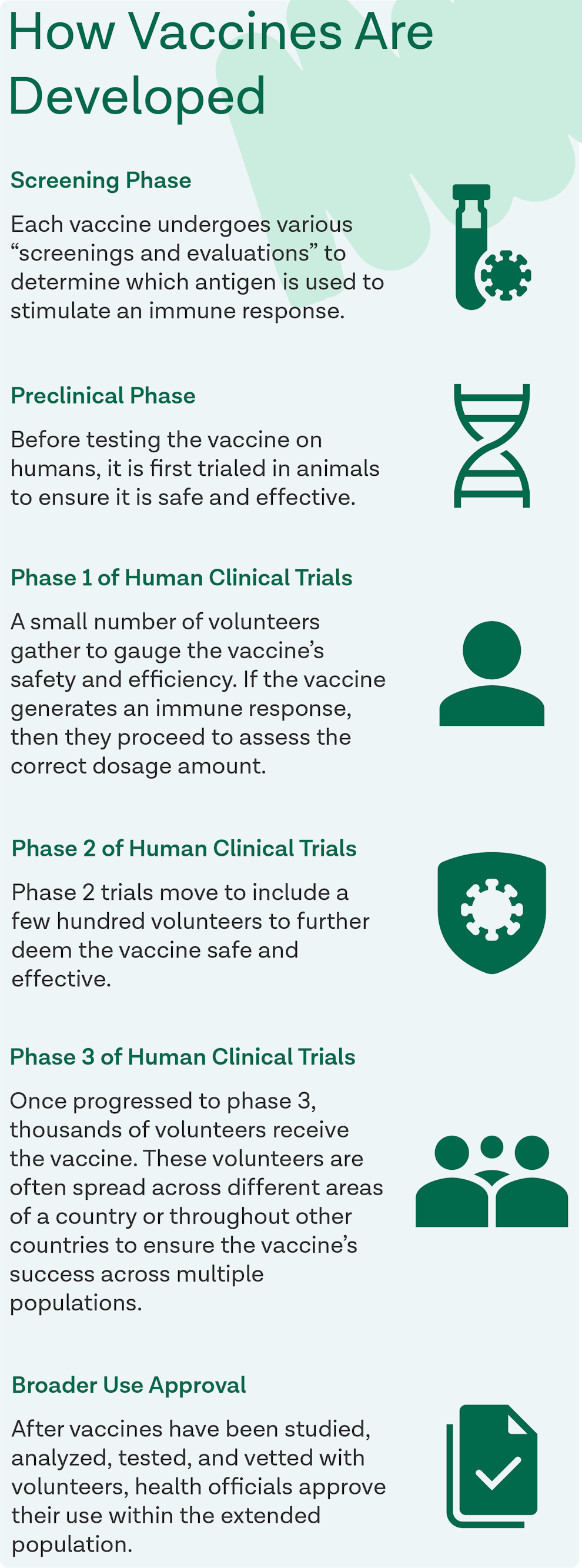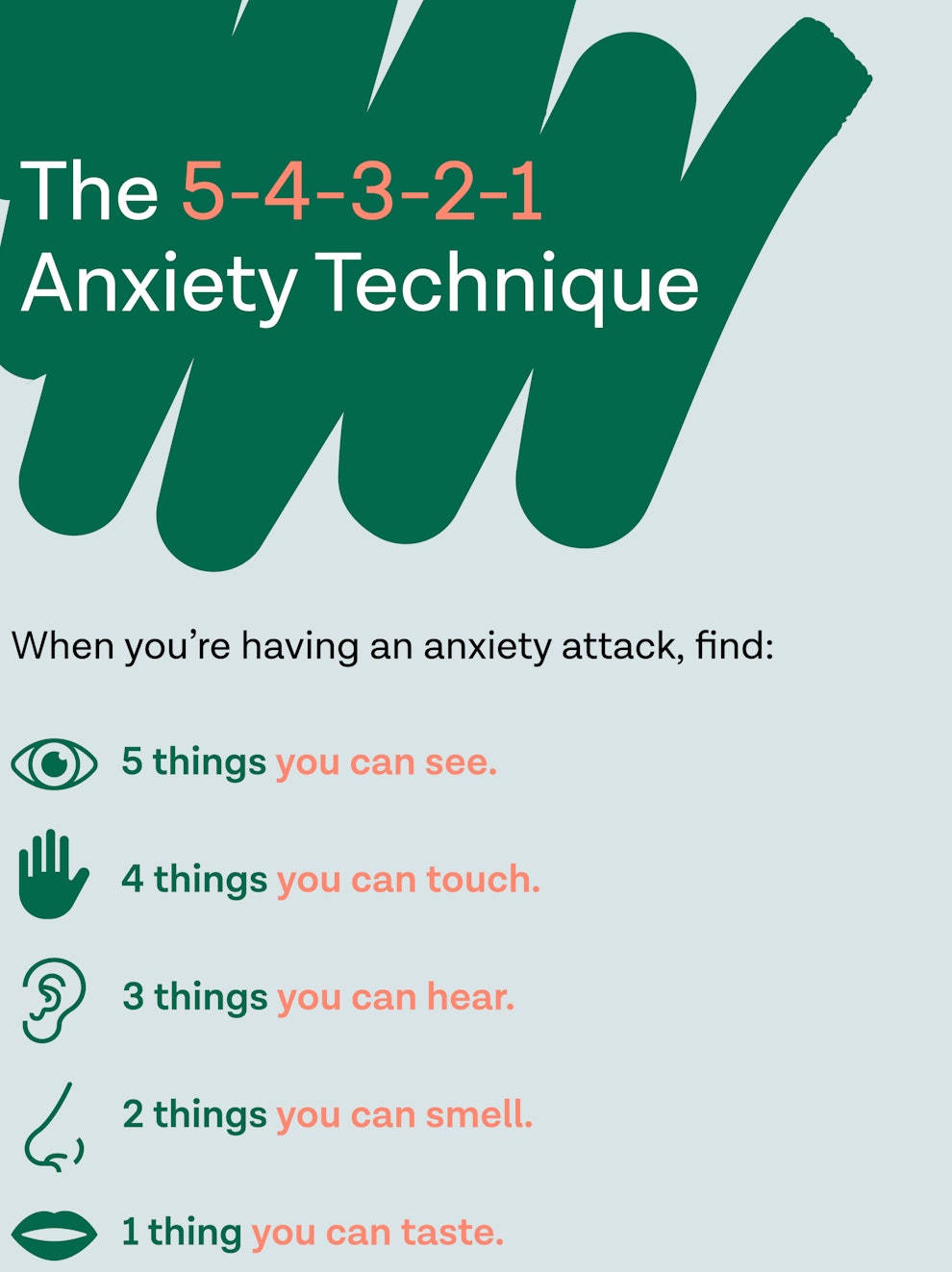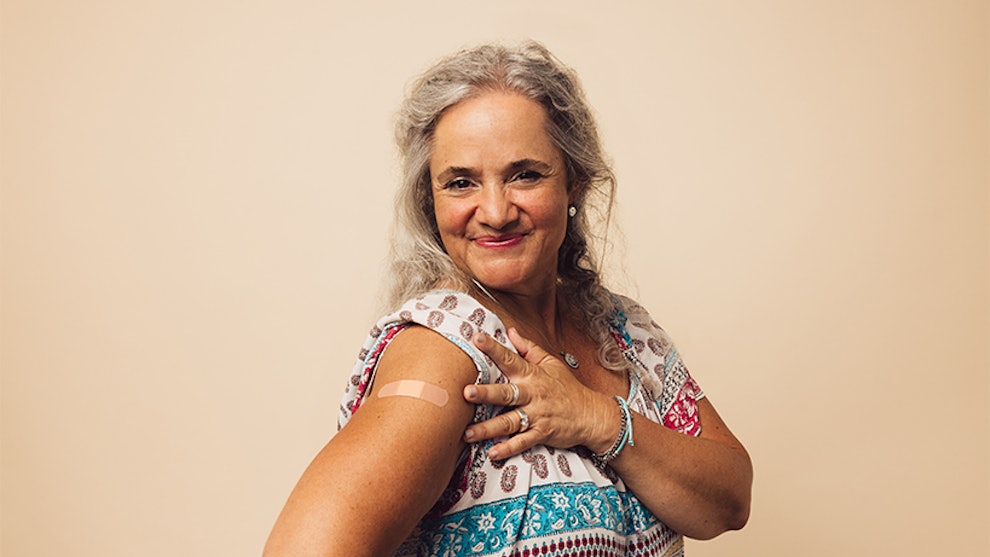Overcoming Vaccine Hesitancy: Understanding Vaccines, Tips to Manage Anxiety, and More
Article at a glance
Knowledge is power. Understanding the history of vaccines is vital when working to overcome vaccine hesitancy and increase vaccine uptake during crucial periods of time (e.g., getting the influenza vaccine during flu season). To learn more about vaccinations (what they are, how they function, etc.), read this section.
Vaccines typically take as long as ten years to be developed. With the COVID-19 vaccine, this timeline was expedited, however, no steps were skipped in the process. To learn more about what a vaccine undergoes before it reaches the general public, read this section.
When addressing vaccine hesitancy, it’s important to note that there is not a one-size-fits-all solution. Instead, there are many methods a patient can take to address vaccine hesitancy in themselves and conquer their fear when practicing vaccination decision-making. To learn more about tips on overcoming vaccine hesitancy, read this section.
Many vaccine-hesitant people fear serious adverse events such as physical harm, typically rooted in a fear of needles. To learn more about specific ways one can work on overcoming a fear of needles, read this section.

Vaccine hesitancy is a widespread issue that affects patients for many different reasons such as fear of harm, fear of mistreatment, being misinformed, and more. However, vaccinations have worked to eradicate a wide range of diseases on top of protecting millions of patients worldwide from catching potentially dangerous illnesses. It is estimated that, in the United States, vaccines prevent 42,000 deaths annually along with preventing 20 million cases of disease when families adhere to the childhood immunization schedule. Furthermore, American Family Physician notes that “from 2001 to 2010, vaccine use resulted in net savings of nearly $14 billion in direct costs and $69 billion in total societal costs.” This goes to show that one of the first steps in becoming less vaccine hesitant is conducting one’s own research and understanding the crucial role vaccines play in our society’s health and wellbeing.
Understanding Vaccinations
Vaccines have been used and developed for centuries, with modern vaccine technology finally advancing by the late 1800s. The purpose of vaccines is to prepare a patient’s body to encounter and fight off certain diseases or illnesses. The ingredients in vaccine doses mimic what a disease’s invading germ would look like, causing the body to fight it off and remember how to attack it if the real germ ever encroaches in the future. Vaccines are considered to be a method of preventive medicine as they proactively work towards protecting a patient’s body from various illnesses.
Due to the help of vaccines, many diseases that were once dangerous and deadly such as smallpox, polio, and measles, have now been declared eradicated from the United States and other countries. ‘Eradicated’ meaning that they no longer exist in the U.S. and have not infected our citizens for a long time. Other vaccine-preventable diseases and illnesses have dwindled in case numbers throughout the years due to vaccine control and immune system boosts throughout society. For example, influenza vaccines have made flu seasons more manageable and childhood vaccines like Varicella have made chickenpox numbers dwindle throughout the years. The reason they were eradicated is because, once a certain number of people in a country’s population have been vaccinated, they gain what is known as ‘herd immunity’, thus suppressing the spread of the targeted virus or bacteria. We continue to see the positive effects vaccinations have on disease control in society, which is why learning how to cope with vaccine hesitancy is more important than ever, especially during the COVID-19 pandemic.
Note: To learn more about vaccination history, how they are administered, what ingredients they contain, and more, visit this source. To learn more specifically about the COVID-19 vaccine, visit this source.

Vaccine Approval Timeline
Typically, a vaccine takes about 5–10 years to be developed as it goes through five different stages prior to reaching approval to ensure vaccine safety. According to the World Health Organization (WHO), these five stages are the screening phase, preclinical phase, phase one, phase two, and finally, phase three.
Screening Phase
Vaccines are first evaluated and screened to determine which antigen will trigger an immune response in the patient.
Preclinical Phase
Once the antigen is discovered, the vaccine is tested on animals to ensure it is safe and efficient prior to trialing it on humans.
Phase 1
The vaccine is first tested on a small set of volunteers to ensure it triggers an immune response. If it does, they proceed to assess what the appropriate dosage amount should be.
Phase 2
A few hundred volunteers are included in this trial and are of all different ages, races, sexes, etc. to determine how different people respond to the vaccine. Multiple trials are included in this phase so that various forms of the vaccine can be evaluated and experimented with.
Phase 3
The vaccine is administered to thousands of volunteers across the country to ensure its efficacy in multiple populations. To avoid bias, some volunteers are given a placebo and the scientists are shielded from knowing who received the vaccine versus the placebo.
Broader Use Approval
Once a vaccine has been analyzed, tested, and vetted by many volunteers throughout the phases, it’s approved to be widely used. Systems such as VAERS are used to monitor the vaccine’s safety and efficacy even after its approval.
It’s important to note that while the COVID-19 vaccine was developed rapidly in comparison to the typical timeline, the vaccine skipped no steps in the process. The coronavirus vaccine was still put through all five stages and vetted by thousands of volunteers prior to it being administered on a wider scale. To learn more about the COVID-19 vaccine’s developmental timeline, visit this source.
Vaccine Hesitancy Causes
There are a variety of factors that can play into the lack of vaccine acceptance for a patient. These factors can range from physical fears such as a fear of needles, vasovagal syndrome, etc. to distrust of the medical community due to decades of being misinformed and/or mistreated. Primary sources of misinformation regarding vaccines include cases such as the Andrew Wakefield scandal or the Tuskegee Study incident.
Andrew Wakefield is a British physician that published a medical journal in 1998 stating that the MMR vaccine puts children at risk of developing Autism. The article was soon refuted and retracted, but it still instilled a sense of fear and confusion surrounding vaccines that has lasted even into the present day. To learn more about Andrew Wakefield’s claims and fraudulent study, visit this source.
The Tuskegee Study occurred in 1932 when the U.S. Public Health Service (USPHS) decided to conduct a study on the natural history of syphilis. The study initially included 600 Black men, 201 of which didn’t even have syphilis. When penicillin was invented and used to treat syphilis in 1943, the participants of the study were denied access to it. Eventually, the study was ruled ‘ethically unjustified’, providing participants and their families with reparations for years to come. However, this study has been a key point in the Black community’s distrust of the medical community and a huge causal factor of vaccine hesitancy amongst this minority group. To learn more about the Tuskegee Study, visit this source.
Tips on Overcoming Vaccine Hesitancy
Since vaccine hesitancy can be rooted in many different factors, it’s important to identify where it stems from before working through how to overcome it. Reflect on why you feel hesitant when it comes to vaccines and speak with a doctor on an action plan that’s best for you to cope with your vaccine anxiety. From a general standpoint, there are a few tips a patient can try when working to conquer their fear.
Confront Your Fear
The first step in overcoming any fear is being able to name what the perceived risk that’s scaring you and confronting it. Take some time to reflect on the reasons why you feel fearful about vaccinations. Journaling down your thoughts or talking through your headspace with loved ones can be a great way to process your fear and pinpoint what’s at the root of it. Once the root cause is addressed, the patient can begin to cope and control it.
Share Your Experience
When working through a fear that is traumatic or overwhelming, it’s important to enlist your support system to help you through the vaccination decision-making process. Share your fear with those you trust and reach out for help when you need it. Especially when the time comes for a doctor’s visit and potentially a vaccine appointment, bring a friend or family member along with you for support and comfort. Not to mention, the more you talk about your fear, the more comfortable you become addressing it and overcoming it. You might even find others who feel the same way, making you feel less alone and more at ease.
Do Your Research
When it comes to your body, it’s good that you’re careful and comfortable about what’s going in it. Take the time to research any vaccinations you’re getting so you understand their ingredients, how they’re administered, the abundant amount of research behind it, and how you could react to it. Of course, there are going to be things you cannot control or comprehend, but speaking with a doctor about those aspects may help clear your mind and feel settled. Read what reputable sources have stated about various vaccines and discuss any concerns or questions with your provider. Feeling like you have all the facts under your wing, will add to your comfort prior to being vaccinated.
Accept What You Cannot Control
It’s impossible to know everything about vaccinations, such as how you will specifically react to them. However, there are parameters that can fill in these gaps and make you feel more comfortable. Practice accepting various factors that you cannot account for or control. Speak with a physician about your worries and work through any questions you may have regarding a particular vaccine.
Be Compassionate
When working through difficult fears and traumatic phobias, it’s vital to practice self-compassion and care. Be sure to maintain a healthy lifestyle so you can keep a clear headspace and minimize your stress levels. A healthy lifestyle includes eating nutritious foods that fuel your body, exercising daily, keeping a consistent sleep schedule, and sustaining hygiene habits. Each of these components leads to you feeling your strongest physically, mentally, and emotionally while undergoing this journey of overcoming vaccine hesitancy.
Practice Relaxation Techniques
Whether it’s at home when processing your fears or at the doctor’s office when preparing to be vaccinated, it’s important to find relaxation techniques and coping strategies that work for you. At home, try physical activities such as yoga, Thai Chi, and/or essential oil therapy to soothe your mind when it’s feeling anxious. When at your doctor’s visits, focus on your breathwork, attempt meditation, and/or listen to soothing music when your vaccine anxiety begins to ramp up. In any setting, when a patient is beginning to feel anxious or overwhelmed, they can participate in the 5–4‑3–2‑1 anxiety technique. This technique is as follows: find 5 things you can see, 4 things you can touch, 3 things you can hear, 2 things you can smell, and 1 thing you can taste. Walking your mind through the five senses allows you to focus your mind away from the anxiety and towards grounding yourself in your body and your environment.
Note: If your vaccine hesitancy is severe and induces intense panic attacks or traumatic episodes of stress, speak with a physician about receiving therapy for your fear. Mental health counseling can help guide you through this process of confronting and overcoming your anxiety surrounding vaccinations.

Tips on Overcoming a Fear of Needles

The fear of needles, otherwise known as trypanophobia, can be induced from a variety of physical or psychological reasons. Because of this, overcoming the fear may also include a mix of physical and psychological methods depending on what it stems from for the patient. Discuss any coping strategies with a doctor to ensure it’s the best route possible for your care. Not to mention, in extreme cases of trypanophobia, healthcare professionals may recommend antianxiety medications to aid heightened stress. General techniques to use when overcoming a fear of needles include but are not limited to:
Look Away
Most procedures that require needles take less than 5 seconds, making it possible for the patient to avoid seeing the needle and feeling it if they simply look away.
Relaxation Techniques
Practice breathwork or mediation techniques to soothe your mind and body prior to the needlework. It might even be helpful to bring calming music to listen to in order to distract yourself from the procedure.
Bring a Loved One
Having a loved one by your side to hold your hand, talk to you, and distract you from the needlework is a great way to subdue your fear.
Numb the Site
Have the provider numb the site with ice or lidocaine prior to the procedure to dull the pain and ensure the patient doesn’t feel the shot.
Expose Yourself to Needles
Watch photos or videos that include needlework such as getting a shot or getting blood drawn to slowly grow comfortable with seeing them in action. Intentionally exposing oneself to their fear can slowly help them grow less intimidated by it.
Tense Your Muscles
If it’s common for a patient to faint at the sight of needles, have them tense their muscles prior to raise their blood pressure and counteract their lightheadedness.
Note: Another common syndrome that causes fainting is known as vasovagal syncope. Vasovagal is triggered when a patient is reacting to something that causes emotional distress such as the sight of blood. Be sure to speak with a doctor if you feel you may be suffering from vasovagal in order to find ways to cope.
Sources
- https://www.who.int/news-room/q‑a-detail/vaccines-and-immunization-what-is-vaccination
- https://www.who.int/news-room/feature-stories/detail/how-are-vaccines-developed
- https://coronavirus.jhu.edu/vaccines/timeline
- https://www.cdc.gov/vaccines/parents/diseases/index.html
- https://www.ncbi.nlm.nih.gov/pmc/articles/PMC3136032/
- https://www.cdc.gov/tuskegee/timeline.htm
- https://www.aafp.org/afp/2016/0715/p94.html#afp20160715p94-b4
- https://omh.ny.gov/omhweb/covid-19-resources/vaccine-anxiety-flyer.pdf
- https://www.urmc.rochester.edu/behavioral-health-partners/bhp-blog/april-2018/5–4‑3–2‑1-coping-technique-for-anxiety.aspx
- https://www.memorialcare.org/blog/how-overcome-fear-needles
- https://www.cedars-sinai.org/blog/techniques-to-overcome-fear-of-needles.html
- https://www.mayoclinic.org/diseases-conditions/vasovagal-syncope/symptoms-causes/syc-20350527
Become a patient
Experience the Oak Street Health difference, and see what it’s like to be treated by a care team who are experts at caring for older adults.



